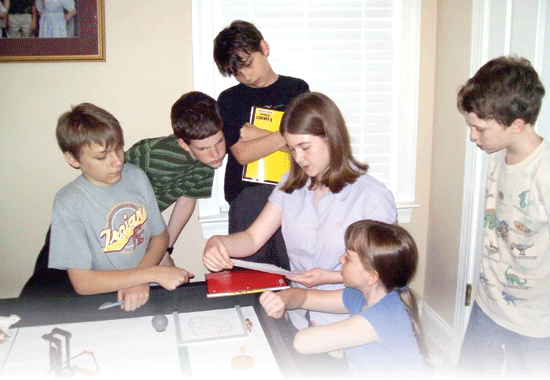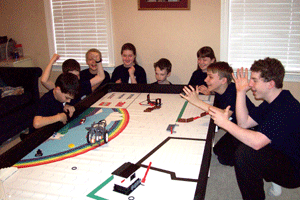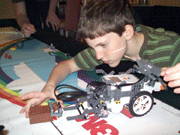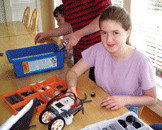
Do you have children who are drawn to building, inventing or
programming? Have you ever wondered how a homeschool curriculum could
help them explore activities in engineering or computer science?
For most of us, the first brush we have with these fields is high school
physics or college computer science. Now, FIRST Lego League (or FLL) is
bringing the excitement of inventing to children ages nine to fourteen
(and ages six to nine for Junior FLL).
FIRST Lego League is a worldwide competition that introduces students to
hands-on robotics and programming. Students also work together as a team
to research and present their ideas for real-world problems. In
addition, the organization stresses the concept of gracious
professionalism, and actually evaluates teams on how they work with
others. With all this going for it, FIRST Lego League is a homeschool
dream . . . for those who can find sponsors and well-educated mentors,
are good at fundraising, and/or have the money to provide their children
this excellent extracurricular adventure.
The Tools
The core of the robotics program is the Lego Mindstorms system. This
includes the NXT brick, several different types of sensors, hundreds of
Lego and Technic pieces, and computer software for programming the
robot. Students learn how to build and program robots with the
educational version, which also contains the FLL handbook, DVDs on the
challenge project and game, and an NXT resource set which contains
hundreds of extra pieces.
The Competition Season
 Beginning in September, teams of four to ten students have about three
to four months to design their robots. They must plan their strategy so
that the robot will accomplish as many missions as possible in two and a
half minutes. The robot challenge is provided by a field set-up kit that
features a four-by-eight foot field mat and mission pieces that must be
built and placed according to the game rules. For an idea of how the
challenge works, visit firstlegoleague.org.
Beginning in September, teams of four to ten students have about three
to four months to design their robots. They must plan their strategy so
that the robot will accomplish as many missions as possible in two and a
half minutes. The robot challenge is provided by a field set-up kit that
features a four-by-eight foot field mat and mission pieces that must be
built and placed according to the game rules. For an idea of how the
challenge works, visit firstlegoleague.org.
The team must also work together to research a community problem, think
up a solution, and create a presentation. The students are encouraged to
network with another team with a similar problem in a different part of
the world. They are also required to share their idea with the
community.
At the competition, teams meet to compete with their robots and make
their presentations before judges. They also have sessions with judges
to answer questions about robot design, programming and teamwork.
Time Commitment
Most teams practice at least four hours a week. Our team met on
Saturdays and divided the time between preparing for the presentation
and creating our robot.
Though the challenge is not announced until September, registration
opens in May. It’s a good idea to register early and use the summer
months to learn how to build and program a robot.
We used the Mindstorms tutorial to build our first robot which we named
“Steve.” Then we used sites from the Internet to try other ideas. Our
goal was to design a robot that could travel forward and backward in a
straight line, and could make consistent turns. (We discovered that this
is harder than you might think.)
 The summer is also a good time to practice using the sensors. FLL allows
two touch sensors, two light sensors, and one ultrasonic sensor.
Students should become comfortable mounting the sensors and creating
programs that use them. Another good goal is to create a moveable arm
using one of the motors.
The summer is also a good time to practice using the sensors. FLL allows
two touch sensors, two light sensors, and one ultrasonic sensor.
Students should become comfortable mounting the sensors and creating
programs that use them. Another good goal is to create a moveable arm
using one of the motors.
Resources
The first stop for a new team is firstlegoleague.org. There you can
register and get detailed information about the challenge and project.
Once you begin, there are a myriad of avenues for learning about robot
design and programming. Many excellent websites such as
www.nxtprograms.com/ provide information on how to build robots.
One of the most useful resources is FIRST Lego League: the Unofficial
Guide by James Floyd Kelly and Jonathan Daudelin. This book contains
guidance on building a team, basic robotics, programming, researching,
and the tournament.
For programming, check out Lego Mindstorms NXT-G Programming Guide by
James Floyd Kelly or this great site: teamhassenplug.org/NXT/NXTGTips/.
Money Matters
Participation in FIRST Lego League is expensive. For the 2008
competition the NXT FLL Robot Set was $365, the Field Set-up Kit was
$65, and registration was $200. There are also tournament fees, which
can run about $100 to $200, plus in some cases transportation to and
lodging at the tournament site. Some teams also make team t-shirts or
hats. Teams have the option of funding their team by recruiting
sponsors, fund-raising, or dividing the cost among families. For a team
of ten students, that would mean raising a minimum of $100 per student.
Most of our homeschool teams were blessed with sponsorship, but two of
our teams raised money by making and selling apple pies.
Some Things We Learned
| Gracious Professionalism
- Gracious attitudes and behaviors are “win-win.”
- Gracious folks respect others and let that respect show through
their actions.
- Gracious professionals make a valued contribution in a manner
pleasing to others and to themselves. They possess special knowledge and
are trusted by society to use that knowledge responsibly.
|
We began our team with nine robotics enthusiasts. We thought they would
focus on robot design rather than research, but we were pleasantly
surprised to find that several students thrived on exploring new ideas.
They enthusiastically participated in digging out resources for our
project, and debated the merits of various findings.
Part of the FLL assignment is to meet experts, and once again several
students connected with this aspect of the project. One of my sons
cornered every engineer who happened to be a guest at our house and
questioned them about our team’s developing ideas. These interviews
provided good material for our homeschool writing assignments.
 Our team also learned that inventing is hard work. Our coach was an
engineer and homeschool father who taught the students to design one
step at a time and then test the results. He taught them to value
consistency in performance. He also taught them to back up their work.
It was entertaining to watch him coach some very imaginative students in
how to come up with a strategy. They learned that after brainstorming
you have to test your ideas and discard those that don’t work.
Our team also learned that inventing is hard work. Our coach was an
engineer and homeschool father who taught the students to design one
step at a time and then test the results. He taught them to value
consistency in performance. He also taught them to back up their work.
It was entertaining to watch him coach some very imaginative students in
how to come up with a strategy. They learned that after brainstorming
you have to test your ideas and discard those that don’t work.
One of our biggest lessons was that there is a lot of room for
inconsistency in the world. We discovered that a robot needs a secondary
means to confirm that it is on the right path. Sensors such as the
infrared sensor (for checking distance from an object) or light sensors
(for identifying a marker on the field mat) can be used to orient the
robot. The programming involved provides an excellent example of the
logic used by computers.
| FIRST Lego League Core Values
- We are a team.
- We do the work to find solutions with guidance from our coaches
and mentors.
- We honor the spirit of friendly competition.
- What we discover is more important than what we win.
- We share our experiences with others.
- We display gracious professionalism in everything we do.
- We have fun.
|
The Tournament
Our first tournament was amazing. While the robots competed at their
tables, the crowds cheered. Our team met dozens of other students who
were excited about robotics. The air of “gracious professionalism” among
both judges and students made this an unusual competition. Many teams
gave out mementos and helped with details like finding a power outlet.
The judges were enthusiastic and encouraged the students in their work.
Our team came home with lots of ideas and motivation for the next year.
The “FIRST” in FIRST Lego League stands for “For Inspiration and
Recognition of Science and Technology.” The founder of FIRST, Dean
Kamen, not only wants to celebrate science and technology, but help
“young people dream of becoming science and technology heroes.” I know
of at least nine future heroes who were being inspired that day.
Joyce McPherson is the creator of the online programs “Homeschool Tools”
and “Shakespeare Tools,” as well as the author of a series of
biographies for Greenleaf Press. With her husband, Garth, she
homeschools their nine children. She can be reached through
teachingtools.org or at mcpclan@comcast.net.